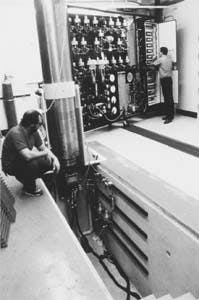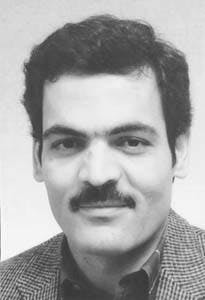TECHNOLOGY Field tests assess novel air-injection EOR processes
Mohammed Reza Fassihi, Travis H. Gillham
Amoco Production Co.
HoustonDemetrios V. Yannimaras
Amoco E&P Technology Group
TulsaDave Hassan
Amoco Canada Petroleum Co.
Calgary
Two ongoing field tests are assessing novel air-injection processes, in situ combustion, for enhancing oil recovery from light and heavy oil fields (Fig. 1 [52426 bytes]).
Amoco Producing Co. operates the light oil test in the West Hackberry field in Cameron Parish, La. This test combines air injection with the double-displacement process.
The other test is Amoco Canada Petroleum Co.'s air-injection project that involves a variation on steam-assisted gravity drainage in horizontal wells. The test is in a thin pay zone containing heavy oil in the Wabasca area, about 250 km north of Edmonton.
Also in its research facility in Tulsa, Amoco is conducting laboratory tests to develop ways for mitigating the risks of air injection.
(Left) The accelerating rate calorimeter (ARC) is one of the special instruments at Amoco's Tulsa laboratory for analyzing the air-injection process (Fig. 3).
(Right) The combustion-tube facility (CTF) combined with the ARC tests oil reactivity with air at reservoir conditions (Fig. 4).
Air injection
Air injection, and the resulting in situ combustion process, uses an inexpensive injectant, air, to accelerate oil recovery and increase recoverable reserves.
Under appropriate conditions, when air is injected into the reservoir, a small amount of oil-in-place is consumed by combustion while the remaining oil is displaced, banked, and eventually produced.
Air is used in heavy-oil reservoirs to generate heat and steam that help mobilize the oil-in-place. For light-oil applications, however, the in situ generated flue gas is the main driving force for oil displacement.
Between 1950 and 1980, many air injection field projects were conducted. However, with the decline in oil prices during the 1980s, the number of air-injection tests also diminished. Today, only a handful of oil companies still have active in situ combustion projects.
Laboratory testing
To select a candidate reservoir for a successful and economical field test of air injection, a company needs certain capabilities, such as an integrated approach (Fig. 2 [49532 bytes]) that includes:
- Performing tests over a wide range of reservoir conditions
- Determining the technical parameters obtained from these tests
- Judging process applicability given a certain oil's reactivity
- Building appropriate numerical models to simulate the lab experiments and obtaining field rates and recovery predictions
- Designing and operating field projects efficiently and safely
- Evaluating field results.
In 1989, Amoco Research began to investigate air injection for recovering additional oil from light and medium-gravity oil reservoirs. A special laboratory was built in Tulsa to study air injection at pressures up to 6,000 psi.
An oil company consortium and the U.S. Department of Energy (DOE) has partially funded the operating cost of the laboratory.
The principal laboratory components are the accelerating rate calorimeter (ARC) and the combustion-tube facility (CTF). These instruments allow for testing of the oil reactivity with air at reservoir conditions (Figs. 3 and 4).
After testing numerous oils, the researchers found1 that candidate reservoirs should have:
- Light to medium-gravity oil, greater than 20° API
- High reservoir temperature, greater than 70° C. (158° F.)
- A reservoir geometry that could help gravity stabilize a gas-injection process. The geometry should include steeply dipping beds, a dome structure, or thin beds.
West Hackberry
In the new application at West Hackberry, Amoco, in cooperation with the DOE, is injecting air into a light-oil reservoir to demonstrate the technical and economic feasibility of combining air injection with the double-displacement process.2
The double-displacement process involves gas displacement of liquids in a water-invaded oil column. The oil is recovered through gravity drainage.
The novel aspect of this project is the use of air as the injectant. The target reservoir is the Camerina C-1, 2, 3 sands on the west flank of the West Hackberry field in Cameron Parish, La. The sands contain a 33° API oil with 0.72 cp viscosity. Reservoir temperature is 202° F. The reservoir watered out in 1993.
Amoco initiated air injection on Nov. 17, 1994. During the first 12 months of operation, mechanical problems within the air-injection surface facilities reduced run time to 40-50%. These problems have been essentially resolved and run time improved to 80-90% during the first quarter of 1996.
Fig. 5 [94074 bytes] plots air injection rate and pressure-vs.-time for the injectors in the main two fault blocks. As a result of air injection, reservoir pressure has increased to 300 psi, and initial production response is predicted for 1996.
While ongoing operations will demonstrate the viability of combining air injection with the double-displacement process, Amoco and the DOE will test a new application for air injection in West Hackberry during 1996.
West Hackberry air injection operations will be expanded to the north flank of the field to test air injection in low-pressure oil reservoirs with large secondary gas caps. The purpose of injecting air into a low-pressure oil reservoir would be to repressurize the reservoir and reposition the oil rim.
The DOE provides financial assistance to the West Hackberry air injection project as part of its Class 1 field demonstration program to develop advanced recovery technologies in fluvial dominated deltaic reservoirs. Louisiana State University is also participating in the project by providing independent study and technology transfer.
Horizontal wells
Horizontal well combustion is a variation of steam-assisted gravity drainage with horizontal wells, and is currently being tested in a thin pay horizon in the Wabasca area about 250 km north of Edmonton.
The Wabiskaw A sand, the main oil-bearing formation, has an average reservoir thickness of 5 m. Its 14° API gravity oil has a viscosity of 5,000-10,000 cp at the reservoir temperature of 15° C (59° F.).
Primary recovery with horizontal wells, as long as 900-1,376 m, has proven economical with an expected recovery of 5-10% of the oil-in-place.
The combustion pilot has a central horizontal air-injection well with two outside horizontal producers (Fig. 6 [52800 bytes]). This is the first time a horizontal well has been used for injecting air.
All three horizontal wells were initially placed on primary production to create some voidage in the reservoir. The central well was then preheated to above 120° C. (248° F.) by injecting steam and then subsequently igniting it by air injection.
After a certain volume of air was injected, the injector was shut-in and the two producers were placed on production Fig. 7 [30484 bytes] shows the pressure decline in the producing wells. The pressure cycling process (Fig. 8 [31155 bytes]) is essential for consuming the oxygen in the injected air and for generating CO2 and CO.
These gases are believed to be retained in the oil phase making it "foamy." The high compressible oil then flows toward the producer during the blow-down period. A similar process was found to yield recoveries as high as 20% in the Morgan combustion cycling tests, using vertical wells.3
The response to date after the first injection cycle has been favorable. Production response on both wells 8-24 and 16-13 was similar to initial primary production from horizontally drilled wells. A total of 3.3% of the original oil-in-place (OOIP) was recovered on primary production prior to starting the pilot. Steam injection of 7,500 cu m CWE (cold water equivalent) lasted from November 1993 until January 1994.
Air injection lasted until May 1994 when two producers were put on production. The closer well (8-24) has shown the best production response.
Oil analysis has not shown any upgrading or emulsion problems. The gas analysis from the producer wells (Fig. 8 [31155 bytes]) suggests that combustion is occurring.
The first production cycle has been running since May 1994 and recently a second injection cycle started.
This improved oil recovery technique may allow the oil industry to extend the life of oil production from thin heavy oil reservoirs.
References
1. Yannimaras, D.V., and Tiffin, D.L., "Screening of Oils for In-Situ Combustion at Reservoir Conditions by Accelerating-Rate Calorimetry," SPE Reservoir Engineering, February 1995, pp. 36-39.
2. Fassihi, M.R., and Gillham, T.H., "The Use of Air Injection to Improve the Double Displacement Process," SPE Paper No. 26374, Annual SPE Conference, Oct. 3-6, 1993.
3. Marjerrison, D.M., and Fassihi, M.R., "Morgan Pressure Cycling In-Situ combustion Project: Performance and Modelling, New Developments in Improved Oil Recovery," editor De Haan, Geological Society Special Publication No. 84, 1995, pp. 275-86.
The Authors
Mohammed Reza Fassihi is a petroleum engineering associate in the resource acquisitions group of Amoco Eurasia in Houston. He was involved with the design and operations of ARCO Resources Technology's first oxygen injection pilot test at Holt Sand Unit in Texas, and Amoco's first field test on air injection at West Hackberry.Fassihi has a BS in chemical engineering from Abadan Institute of Technology in Iran and an MS in chemical engineering and a PhD in petroleum engineering from Stanford University. He is a member of SPE.
Demetrios V. Yannimaras is a staff research engineer in Amoco's E&P Technology Group in Tulsa. For the past 6 years, he has investigated the air-injection process as a means of inexpensive EOR and the importance of oxidation reaction kinetics of crude oil/air systems. Yannimaras has BS, MS, and PhD degrees in mechanical engineering from Northwestern University.
Travis Gillham is the project manager for Amoco's West Hackberry Air injection project. He has worked for Amoco in operations and reservoir engineering for the last 16 years. Gillham has a BS in chemical engineering from the University of Southwestern Louisiana.
Dave Hassan is senior staff operations engineer in Amoco Canada's Wabasca property management team. He has been involved in all facets of heavy oil recovery. Hassan has a BS in geotechnical engineering from the University of Toronto. He is a member of the Petroleum Society and the Association of Professional Engineers, Geologists and Geophysicists of Alberta (Apegga).
Copyright 1996 Oil & Gas Journal. All Rights Reserved.





